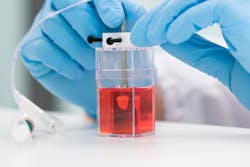AstraZeneca Joins Novoheart to Develop Heart-in-a-Jar Model of Heart Failure
Heart failure is a global pandemic with an estimated 64.3 million cases worldwide in 2017.
In half of these cases, preserved ejection fraction (HFpEF) is the reason for the failure. This a common condition among the elderly and especially in women, with the reported prevalence approaching 10% in women over the age of 80 years.
Its pathological mechanisms and diverse etiology are poorly understood. Due to these complexities, models of the disease available to date, including various animal models, have limited ability to mimic the clinical presentation of HFpEF.
The result is that drug developers lack an effective tool for preclinical testing of drug candidates for efficacy, and clinical outcomes for HFpEF have not improved over the last decades, with no effective therapies available.
To help change all of that Novoheart, a stem cell biotechnology company, joined with AstraZeneca and on Nov. 26 announced a joint effort to develop the world’s first human-specific in vitro, functional model of heart failure with preserved ejection fraction (HFpEF).
In collaboration with the Cardiovascular, Renal and Metabolism therapy area of AstraZeneca, the initial phase of the project aims to establish a new in vitro model, leveraging Novoheart’s 3-D human ventricular cardiac organoid chamber (hvCOC) technology, that reproduces key phenotypic characteristics of HFpEF.
Also known as “human heart-in-a-jar”, the hvCOC contains human-engineered heart tissue that enables clinically informative assessment of human cardiac pump performance including ejection fraction and developed pressure.
Unlike animal models, engineered hvCOCs can be fabricated with specific cellular and matrix compositions, and patient-specific human induced pluripotent stem cells (iPSCs), that allow control over their physical and mechanical properties to mimic those observed in HFpEF patient hearts.
“This could bridge the gap between in vivo animal models and clinical trials to help accelerate the drug discovery process by providing human-specific preclinical data,” said Regina Fritsche Danielson, senior vice president, Head of Research and Early Development, Cardiovascular, Renal and Metabolism, BioPharmaceuticals R&D, AstraZeneca.
About the Author
IW Staff
Find contact information for the IndustryWeek staff: Contact IndustryWeek
